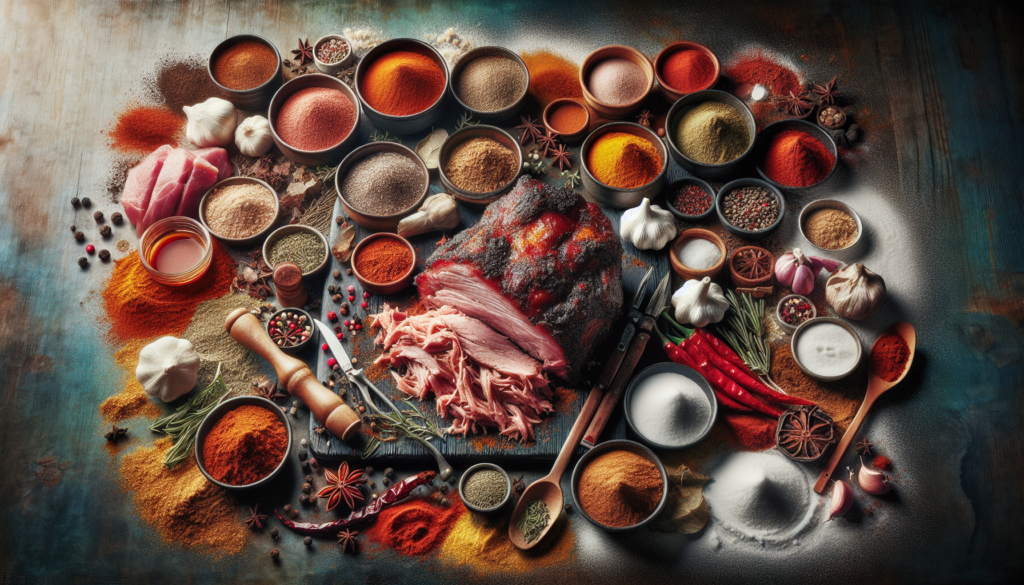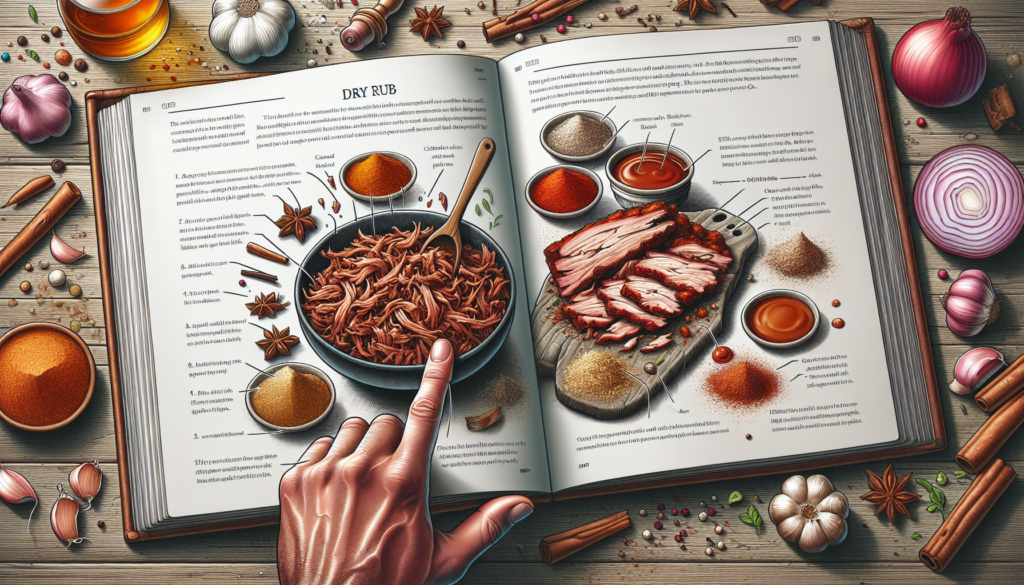If you’re craving a tender and delicious pulled pork, then you’ll definitely want to learn how to make a flavorful dry rub that will take your recipe to the next level. With just a few simple ingredients and a little bit of time, you can create a mouthwatering blend of flavors that will enhance the natural taste of the pork and leave you wanting more. Whether you’re a seasoned pitmaster or a beginner in the kitchen, this article will guide you through the process of making a dry rub that will impress your guests and have them asking for your secret recipe. So grab your apron and get ready to create a delicious masterpiece that will have everyone coming back for seconds.

Choosing the Right Ingredients
When it comes to making a flavorful dry rub for pulled pork, selecting the right ingredients is the first and crucial step. The perfect combination of spices, herbs, sweeteners, and tangy flavors will create a delicious and mouthwatering crust on your pork. Let’s dive into each category to understand how you can make the best choices.
Selecting the Meat
Before even thinking about the dry rub, it’s essential to start with high-quality pork. Opt for a cut that is marbled with fat, such as pork shoulder or Boston butt, as these cuts are perfect for slow cooking and will result in tender, juicy pulled pork. Make sure to choose well-sourced, fresh meat to ensure the best flavor and texture in your final dish.
Essential Spices and Herbs
Spices and herbs are the heart of any dry rub. They add depth, complexity, and aroma to your pulled pork. Some common spices used in dry rubs include paprika, chili powder, cumin, and garlic powder. Herbs such as thyme, oregano, and rosemary can also add a fresh and fragrant element to the mix. Experiment with different combinations of spices and herbs to find the perfect balance that suits your taste preferences.
Sweeteners and Tangy Flavors
To balance the heat and add a touch of sweetness or tanginess to your dry rub, incorporating sweeteners and tangy flavors is essential. Brown sugar, honey, or maple syrup can provide a rich sweetness, while apple cider vinegar or citrus zest can bring a tangy twist to your rub. Play around with these ingredients to find the right level of sweetness and tang that complements the smoky flavors of the pork.
Preparing the Pork
Once you have gathered the perfect ingredients for your dry rub, it’s time to prepare the pork. Properly preparing the meat ensures that it absorbs the flavors of the rub and results in a tender and juicy final product.
Trimming Excess Fat
Before applying the dry rub, it’s a good idea to trim any excess fat from the surface of the pork. While a little fat can add flavor and moisture, too much fat can hinder the absorption of the dry rub and prevent it from forming a nice crust. Trim the fat to about a quarter-inch thickness, leaving enough to add flavor without overwhelming the meat.
Brining the Meat
To further enhance the flavor and moisture of your pulled pork, consider brining the meat before applying the dry rub. Brining involves soaking the meat in a mixture of salt, sugar, and water for a few hours or overnight. This process helps to impart flavor and tenderness to the pork, resulting in a more succulent and flavorful end result. Rinse the meat well after brining to ensure that it isn’t overly salty before adding the dry rub.
Letting it Rest
After trimming excess fat and brining the meat, allow it to rest at room temperature for about 30 minutes. This resting period allows the pork to come to an even temperature and ensures that the dry rub adheres well to the surface. During this time, you can prepare the dry rub and let the anticipation build for the flavorful feast that awaits you.
Creating the Dry Rub
Now that your pork is prepared and ready, it’s time to create the star of the show – the dry rub itself. The dry rub is a mixture of spices and herbs that will coat the meat, infusing it with flavor and creating a mouthwatering crust.
Balancing Flavors
When creating the dry rub, achieving the right balance of flavors is key. You want a combination of savory, smoky, sweet, and tangy flavors that work harmoniously together. Start with a base of salt and sugar, then experiment with different proportions of spices, herbs, and other flavor enhancers to find the perfect balance for your taste buds.
Experimenting with Spice Levels
Not everyone has the same tolerance for spice, so adjusting the heat level of your dry rub is important. If you enjoy a mild flavor, use spices like smoked paprika, ground cumin, and onion powder. For those who prefer a spicier kick, cayenne pepper, chipotle powder, or even a touch of habanero can be added. Remember to start with smaller amounts of the hotter spices and gradually increase them until you achieve your desired level of heat.
Using a Base of Salt and Sugar
Salt and sugar are foundational ingredients in any dry rub. Salt helps to enhance the natural flavors of the meat while also aiding in the tenderization process. Brown sugar, white sugar, or even maple syrup can be used to balance the savory notes and add a touch of sweetness. The combination of salt and sugar in your dry rub will help to create a caramelized crust on the pork while keeping it moist and juicy inside.
Adding Depth and Complexity
To take your dry rub to the next level and add depth and complexity to the flavor profile, consider incorporating some special ingredients that bring a unique twist to the mix.
Incorporating Smoked Paprika
Smoked paprika is an incredibly versatile spice that adds a smoky and earthy flavor to your dry rub. It comes in both sweet and spicy varieties, so choose the one that best complements your overall flavor profile. Smoked paprika not only enhances the aroma of the meat but also gives it a beautiful reddish hue, making your pulled pork look as good as it tastes.
Including Ground Coffee
Ground coffee might seem like an unusual addition, but it can work wonders in a dry rub for pulled pork. The natural bitterness of the coffee adds complexity to the overall flavor profile and pairs exceptionally well with the smokiness of the pork. Choose a medium to dark roast coffee for a more intense and robust flavor. Just be sure to use ground coffee, not instant, to avoid any artificial flavors or additives.
Enhancing with Mustard Powder
Mustard powder is another ingredient that can add a unique and tangy flavor to your dry rub. It provides a subtle heat and a distinct tang that cuts through the richness of the pork. Use it in moderation, as a little goes a long way. Mustard powder works particularly well when combined with other spices like paprika, cumin, and garlic powder, allowing the flavors to meld together and take your dry rub to new heights.

Balancing Heat and Sweetness
The interplay of heat and sweetness in a dry rub is what sets it apart and brings about a harmonious explosion of flavors. Finding the right balance between the two is crucial to creating a mouthwatering dry rub for your pulled pork.
Considering Cayenne Pepper
Cayenne pepper is an excellent choice if you want to add heat to your dry rub. It packs a punch and can elevate the overall flavor profile of your pulled pork. However, it’s important to use it in moderation, especially if you’re sensitive to spice. Start with a small amount and adjust according to your preference. Remember, you can always add more later, but it’s challenging to lessen the heat once it’s too overpowering.
Using Chipotle Powder
Chipotle powder is a smoky, dried, and ground form of jalapeno peppers. It adds a unique depth of flavor and a touch of heat to your dry rub. If you prefer a medium level of spiciness with a rich smokiness, chipotle powder is the way to go. It pairs exceptionally well with brown sugar and spices like cumin and garlic powder, creating a delicious balance between smoky, sweet, and spicy notes.
Exploring Brown Sugar Options
When it comes to sweeteners in a dry rub, brown sugar is a go-to ingredient for many. It provides a rich caramel flavor and helps to balance out the heat and spices. However, don’t limit yourself to just traditional brown sugar. Experiment with different varieties like turbinado or even dark muscovado sugar for a deeper and more complex sweetness. These alternatives can bring a caramelized richness to your pulled pork, making it truly irresistible.
Exploring Aromatic Possibilities
Aromatics play a crucial role in creating a flavorful dry rub that tantalizes the taste buds. Including a blend of dried herbs, onion, and garlic powder, and ground cumin can take your dry rub to new heights of aroma and complexity.
Trying Onion and Garlic Powder
Onion and garlic powder are staples in spice racks for good reason. They add depth and savory notes to your dry rub, enhancing the overall flavor profile of the pulled pork. They also contribute a subtle sweetness and help to create an enticing aroma that will have your family and friends eagerly awaiting their first bite. Experiment with different ratios of onion and garlic powder to find the perfect balance that suits your preferences.
Experimenting with Dried Herbs
Dried herbs, such as thyme, oregano, and rosemary, can bring a burst of freshness and fragrance to your dry rub. They provide a contrast to the savory and smoky flavors, giving your pulled pork a well-rounded taste experience. The earthiness of dried herbs can complement the richness of the meat and add a layer of complexity to your dish. Crush the dried herbs between your fingers before adding them to the dry rub to release their oils and maximize their flavors.
Including Ground Cumin
Ground cumin is another key ingredient that can elevate the aromatic profile of your dry rub. With its warm and earthy flavor, cumin enhances the overall taste of the pulled pork and creates a beautiful harmony with other spices and herbs. It plays well with both sweet and savory elements, making it a versatile choice that can complement a variety of flavor combinations. Just a touch of ground cumin can add a unique depth to your dry rub.
Injecting Moisture and Flavor
To ensure your pulled pork is moist and bursting with flavor, consider incorporating a few liquid ingredients into your dry rub. These additions will not only enhance the taste but also infuse the meat with a succulent texture.
Using Worcestershire Sauce
Worcestershire sauce is a classic ingredient often used in marinades, sauces, and dry rubs. Its umami-rich flavor adds depth and complexity, enhancing the taste of the pork. Just a small amount of Worcestershire sauce can go a long way in creating a flavorful dry rub. The mixture of savory, sweet, and tangy flavors in Worcestershire sauce complements the other ingredients in the rub, giving your pulled pork an extra layer of deliciousness.
Adding Apple Cider Vinegar
Apple cider vinegar is a pantry staple known for its versatility and tangy flavor. When added to your dry rub, it can help tenderize the meat and create a more intense flavor profile. The acidity of the vinegar breaks down the connective tissues in the pork, resulting in a succulent and tender pulled pork. Additionally, the tanginess of the apple cider vinegar pairs beautifully with the smokiness and heat from the spices, creating a well-rounded and tantalizing taste experience.
Including Liquid Smoke
If you want to enhance the smoky flavor of your pulled pork, consider incorporating liquid smoke into your dry rub. Liquid smoke is derived from real wood smoke and can add an intense smokiness to your pork, mimicking the flavors of traditional barbecue. Use it sparingly, as a little goes a long way. Experiment with different types of liquid smoke, such as hickory or mesquite, to find the one that complements your taste preferences the best.
Applying the Dry Rub
Now that your dry rub is prepared and the pork is perfectly seasoned, it’s time to apply the rub to the meat. Properly applying the dry rub ensures that the flavors penetrate the pork, creating a delicious crust and infusing the meat with all the aromatic goodness.
Generously Coating the Meat
To ensure a well-seasoned and flavorful pulled pork, generously coat the meat with the dry rub. Use your hands to massage the rub onto all sides of the pork, ensuring that every nook and cranny is covered. The rub should adhere to the surface, forming a flavorful crust during the cooking process. Don’t be shy – the more dry rub you apply, the more intense and delicious the final result will be.
Rubbing in a Circular Motion
When applying the dry rub, use a circular motion to massage it into the meat. This technique helps to evenly distribute the flavors and ensures that they penetrate the layers of the pork. Be gentle yet thorough, making sure that the rub is fused into the meat and not just sitting on the surface. The circular motion allows for better coverage and helps the rub to penetrate the meat, resulting in a more flavorful and succulent pulled pork.
Allowing the Flavor to Infuse
Once the dry rub is applied, allow the pork to rest for at least 30 minutes before cooking. During this time, the flavors will begin to penetrate the meat, infusing it with all the deliciousness of the rub. This resting period also allows the meat to come to room temperature, ensuring more even cooking.
Letting the Rub Rest
After applying the dry rub to the pork, it’s essential to let it rest before cooking. This resting period allows the flavors to meld and intensify, resulting in a more flavorful and succulent end result.
Refrigerating Overnight
For the best flavor development, it’s recommended to let the pork rest in the refrigerator overnight. This extended resting period allows the flavors of the dry rub to fully permeate the meat, resulting in a more intense and delicious taste. It also helps to tenderize the pork and ensures that it absorbs all the flavorful goodness. Cover the pork with plastic wrap or place it in an airtight container to prevent any cross-contamination in the refrigerator.
Covering with Plastic Wrap
To retain moisture and prevent the dry rub from drying out, cover the pork with plastic wrap during the resting period. This will keep the flavors sealed in and ensure that the meat stays juicy and succulent. Make sure the plastic wrap is tightly sealed to minimize air exposure and maintain the optimum moisture level within the pork.
Retaining Moisture and Flavor
Allowing the dry rub to rest on the pork before cooking not only allows the flavors to develop but also helps to retain moisture. As the rub rests on the surface of the meat, it creates a barrier that helps to lock in the natural juices, ensuring a tender and juicy pulled pork. This resting period is a crucial step in the preparation process that will elevate your pulled pork to new heights of deliciousness.
Smoking or Slow Cooking the Pork
The final step in creating a flavorful dry rub for pulled pork is choosing the right cooking method and ensuring that the pork is cooked to perfection.
Choosing the Cooking Method
There are various cooking methods you can use to cook your dry-rubbed pork, but the most popular ones are smoking and slow cooking. Smoking involves cooking the pork over low heat and indirect smoke, which results in a tender and smoky flavor. Slow cooking, on the other hand, involves cooking the pork at a low temperature in an oven or slow cooker for an extended period, allowing the meat to become tender and succulent. Choose the cooking method that best suits your available equipment and personal preference.
Monitoring Temperature
No matter which cooking method you choose, it’s crucial to monitor the temperature of the pork throughout the cooking process. Use a meat thermometer to ensure that the internal temperature reaches a safe level and that the pork is cooked to perfection. For pulled pork, a target internal temperature of around 195-205°F (90-96°C) is recommended. This ensures that the connective tissues break down, resulting in tender and easily shredded meat.
Cooking Low and Slow
Whether you’re smoking or slow cooking the pork, the key is to cook it low and slow. This allows the flavors of the dry rub to develop and meld with the meat, resulting in an incredibly tender and flavorful end product. The low temperature and longer cooking time allow the collagen in the pork to break down and transform into gelatin, resulting in a succulent and moist pulled pork that practically melts in your mouth. Patience is the secret ingredient here – slow cooking is well worth the wait.
In conclusion, making a flavorful dry rub for pulled pork requires careful ingredient selection, proper preparation of the meat, and the right balance of spices, herbs, sweeteners, and tangy flavors. By following the steps outlined in this article, you will be well on your way to creating a mouthwatering dry rub that will take your pulled pork to new heights of flavor and deliciousness. So gather your ingredients, fire up the smoker or slow cooker, and get ready to savor the incredible results of your homemade dry rub. Enjoy!
